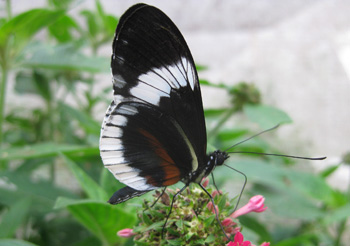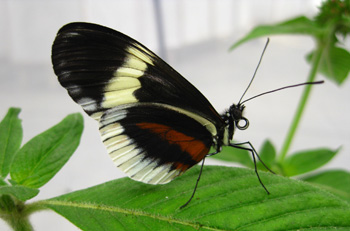Breaking up may actually not be hard to do, say scientists who've found a population of tropical butterflies that may be on its way to a split into two distinct species. The cause of this particular break-up? A shift in wing color and mate preference.
![]() AUSTIN, Texas — Breaking up may actually not be hard to do, say scientists who've found a population of tropical butterflies that may be on its way to a split into two distinct species.
AUSTIN, Texas — Breaking up may actually not be hard to do, say scientists who've found a population of tropical butterflies that may be on its way to a split into two distinct species.
The cause of this particular break-up? A shift in wing color and mate preference.
In a paper published this week in the journal Science, the researchers describe the relationship between diverging color patterns in Heliconius butterflies and the long-term divergence of populations into new and distinct species.
"Our paper provides a unique glimpse into the earliest stage of ecological speciation, where natural selection to fit the environment causes the same trait in the same population to be pushed in two different directions," says Marcus Kronforst, a Bauer Fellow in the Center for Systems Biology at Harvard University who received his doctor's degree at The University of Texas at Austin. "If this trait is also involved in reproduction, this process can have a side effect of causing the divergent subpopulations to no longer interbreed. This appears to be the process that is just beginning among Heliconius butterflies in Ecuador."
Heliconius butterflies display incredible color pattern variation across Central and South America, with closely related species usually sporting different colors. In Costa Rica, for example, the two most closely related species differ in color: One species is white and the other is yellow. In addition, both species display a marked preference to mate with butter-flies of the same color.
The Ecuadorian population examined by Kronforst and his colleagues shows the same white and yellow variation found in Costa Rica but has not yet reached a level of strong reproductive isolation. The entire population lives in close proximity and individuals of both colors come in contact with - and mate with - each other.
But, by studying the Ecuadorian population in captivity, the scientists found the two colors do not mate randomly. Despite the genetic similarity between the groups - white and yellow varieties differ only at the color-determining gene - yellow Ecuadorian individuals show a preference for those of the same color. White male butterflies, most of which are heterozygous at the gene that controls color, show no color preference.
"This subtle difference in mate preference between the color forms in Ecuador may be the first step in a process that could eventually result in two species, as we see in Costa Rica," says Kronforst, who began studies of Heliconius color pattern and behavioral genetics in the laboratory of Professor Lawrence Gilbert at The University of Texas at Austin.
 Previous studies of species formation have focused on the characteristics of well-differentiated species, and the health and viability of their hybrids in particular, in an effort to identify how the species may have emerged and how they stay distinct.
Previous studies of species formation have focused on the characteristics of well-differentiated species, and the health and viability of their hybrids in particular, in an effort to identify how the species may have emerged and how they stay distinct.
Heliconius provides a model for a different kind of study. The researchers considered species emergence from the opposite end, studying populations that have yet to diverge into separate species in order to identify the role of mate choice in the potential emergence of new species.
Having identified color-based mate preference in Heliconius, the researchers used a battery of genetic markers to compare the genomes of the white and yellow varieties, showing that they are genetically identical except for their different colors and preferences.
Their work suggests that the genes for color and preference are very close to one another in the genome; the two traits could even be caused by the same gene. Their next step is to identify the gene (or genes) responsible for the differences in color and mate preference.
 "If we can identify this gene or genes, we can say conclusively how they influence both color and mate choice," says Kronforst. "Subsequent work could elucidate exactly how changes in individual genes can, over long periods of time, lead to novel species."
"If we can identify this gene or genes, we can say conclusively how they influence both color and mate choice," says Kronforst. "Subsequent work could elucidate exactly how changes in individual genes can, over long periods of time, lead to novel species."
"This study shows the great potential of the genus Heliconius as a model system for integrating genetics, development, behavior, ecology and evolution," says Gilbert, professor in the Section of Integrative Biology. "It is the culmination of diverse contributions of the co-authors involving insectary, field and laboratory research over more than a decade."
Co-authors on the Science paper with Kronforst are Nicola L. Chamberlain and Ryan I. Hill, both of Harvard; Durrell D. Kapan of the University of Hawaii; and Lawrence E. Gilbert of The University of Texas at Austin. Their work was funded by the National Science Foundation and the National Institutes of Health.
Gilbert can be reached at lgilbert@mail.utexas.edu. Kronforst can be reached at mkronforst@cgr.harvard.edu.
For more information, contact:Lee Clippard, College of Natural Sciences, 512-232-0675; Steve Bradt, Harvard University, 617-496-8070.
















Comments 2
what are the benefits of green tea, A formidable proportion, I just given this onto a colleague who was once doing a bit of analysis on this. And he in fact purchased me breakfast because I found it for him.. smile. So allow me reword that: Thnx for the treat! However yeah Thnkx for spending the time to debate this, I really feel strongly about it and love studying extra on this topic. If possible, as you turn into experience, would you thoughts updating your weblog with extra details? It's highly useful for me. Big thumb up for this weblog post!
I seriously love your site.. Very nice colors & theme. Did you make this site yourself? Please reply back as I’m looking to create my very own website and want to know where you got this from or just what the theme is called. Many thanks!